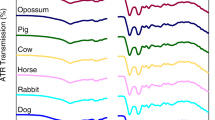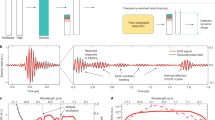Abstract
ALTHOUGH it has been known for nearly a hundred years1 that the red pigment of the circulatory fluid of non-rhynchobdellid leeches is haemoglobin, there appear to be no records of the absorption-spectrum or of its main features. While removing the blood from the tissue-pigments of leeches I have had occasion to record the absorption-spectra in neutral aqueous solutions of the oxyhaemoglobin of Hirudo medicinalis L, Haemopis sanguisuga (L) and Erpobdella testacea (Savigny). The spectrum for Hirudo is shown in. Fig. 1, and the positions of the main features in the spectra of all three genera are given in Table 1.
This is a preview of subscription content, access via your institution
Access options
Subscribe to this journal
Receive 51 print issues and online access
$199.00 per year
only $3.90 per issue
Buy this article
- Purchase on Springer Link
- Instant access to full article PDF
Prices may be subject to local taxes which are calculated during checkout
Similar content being viewed by others
References
Lankester, E. Ray, Proc. Roy. Soc., B, 21, 70 (1872).
Prosser, C. L., and Brown, jun., F. A., Comparative Animal Physiology, 201 (W. B. Saunders, Philadelphia, 1960).
Keilin, D., and Wang, Y. L., Biochem. J., 40, 855 (1947).
Fox, H. Munro, Proc. Roy. Soc., B, 135, 192 (1948); 136, 388 (1949); 138, 514 (1951); 141, 179 (1953); 143, 203, 214 (1955).
Author information
Authors and Affiliations
Rights and permissions
About this article
Cite this article
NEEDHAM, A. Absorption-spectrum of Haemoglobin of Leeches. Nature 210, 427–428 (1966). https://doi.org/10.1038/210427a0
Issue Date:
DOI: https://doi.org/10.1038/210427a0
This article is cited by
-
Absorption Spectrum of Leech Haemoglobin: a Correction
Nature (1969)
Comments
By submitting a comment you agree to abide by our Terms and Community Guidelines. If you find something abusive or that does not comply with our terms or guidelines please flag it as inappropriate.



